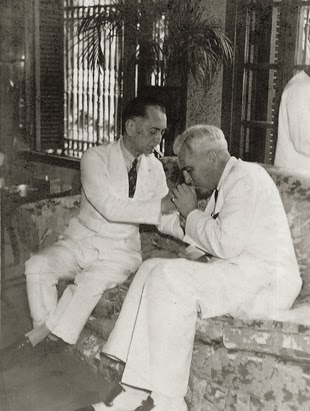'El Nido', the Eugene Arthur Perkins residence along Dewey Boulevard in Ermita. Ⓒ Manila Nostalgia/Lou Gopal
In pre-war Manila, houses of illustrious families were designed by well-known architects according to their elegant tastes. Their homes were either designed in the renaissance, art-deco, beaux-arts, or the traditional Filipino bahay na bato style. But one house stood out among the rest, and this was the El Nido, the residence of Eugene Arthur 'E.A.' Perkins, and his wife Idonah Slade. The house and the family became the center of intrigue among Manila's high society because of domestic quarrels between Eugene and Idonah.
The owner of the house, E.A. Perkins, was the first American envoy to the Royal Court of Siam (Thailand's counterpart of the Royal Court of St. James). Born in Bangkok in 1888, he went to Manila and became a partner of the law firm DeWitt, Perkins, and Brady. In 1935, Sen. Juan Ponce Enrile's father Alfonso Ponce Enrile joined the firm and was renamed DeWitt, Perkins, Brady, and Ponce Enrile. Their law firm was located in Edificio Soriano (formerly as the Geronimo de los Reyes Building) in Plaza Cervantes.
E.A. Perkins (right), checking the shipment of Lepanto gold with Hong Kong and Shanghai Bank manager W. Webster (right) in 1949. Ⓒ Lougopal.com/Manila Nostalgia
The Perkins residence was designed by the great Andrés Luna de San Pedro in the Moorish Mediterranean style. The house, which faces the Manila Bay, was located in the residential section of Ermita, where homes of prominent Filipino and expatriate families once stood. As their home stood out among the rest, it won the title of The 'Most Beautiful Home of 1928', a year before the Zóbels won theirs a year later.
Dewey Boulevard and its environs in the 1920s. the El Nido was located at the corner of Dewey Boulevard and Calle Divisoria (now Salas St.). Ⓒ Lougopal.com/Manila Nostalgia
The penthouse living room of the Perkins residence in Ermita. Ⓒ Manila Nostalgia/Isidra Reyes
One of the rooms inside the El Nido. Ⓒ Manila Nostalgia/Isidra Reyes
When the Philippines became a commonwealth in 1935, the American governor-general had moved out of Malacañang Palace and was replaced by a High Commissioner (an equivalent of an ambassador). The High Commissioner was in need of his own residence. So, in 1937 when the newly-appointed High Commissioner Paul V. McNutt arrived in Manila, Attorney E.A. Perkins offered his El Nido to be McNutt's home until a permanent residence for the High Commissioner is finished.
President Manuel L. Quezón (left) enjoying cigarettes with American High Commissioner Paul V. McNutt (right). Ⓒ Jweekly.com
In the 1950s, shortly before E.A. Perkins died, he sold his property. The new owner had the El Nido demolished and was replaced by an apartment known as the L&S Building, which was designed by Alfredo Luz.







That has to be the photo that exists of the area surrounding "El Nido". 99% of the photos just reflect the outside of the home so the photos of the interior of the home are intriguing. It is interesting to note that the U.S. Army/Navy and Elks Clubs exist just down the street. AWESOME!
ReplyDelete